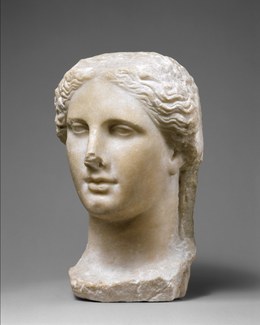Head of a Ptolemaic Queen

Images copyright © The Metropolitan Museum of Art. Image source: Art Resources, NY
This monumental head, acquired by George Baldwin, British consul-general in Egypt in 1785-96, is made of imported marble and was originally inserted in a full-body statue of a queen. Individual details and attributes of royal Ptolemaic sculptures were often added in stucco; in this head, the rough carving at the top and back of the head suggests that a veil as well as a diadem or a stephane—both symbols of royalty used by Ptolemaic queens—were worked and added separately. The woman’s most notable features are round fleshy cheeks and a short chin, traits that are recognizable in coin portraits of queen Arsinoe II, two examples of which are also on display in the exhibition. The composition is otherwise based on idealized elements that were used in the Hellenistic sculptural tradition for the depiction of divinities, queens, and notable females, thus making the identification with Arsinoe II possible but not certain.